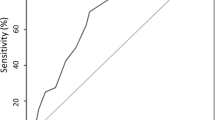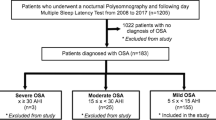Abstract
Purpose
To determine the relationship between the Epworth Sleepiness Scale (ESS) and the Subjective Sleep Quality (SSQ) or polysomnographic (PSG) features in patients with sleep-disordered breathing (SDB).
Methods
This is a retrospective study that included 646 untreated patients with a PSG diagnosis of primary snoring (PS) or obstructive sleep apnea syndrome. Patients with SDB were grouped into four categories according to ESS scores: no diurnal sleepiness (DS) = 0-6; mild DS = 7–12; moderate DS = 13–18, and severe DS = ≥19. Analyses of variance were performed to compare SSQ or PSG features among the four ESS severity categories.
Results
We found a significant increase in subjective sleep time in the group of patients with severe DS. With regard to PSG data, we also identified increases in total sleep time (TST) and rapid eye movement (REM) in the group of patients with severe DS.
Conclusion
Unexpectedly, DS severity was related with increases in TST and REM sleep. As has been described in SDB patients, a change in muscular tonus throughout sleep onset (and depth) is a causal factor of SDB features and DS impairment. Therefore, we propose that increases in TST and REM are worsening factors of SDB and consequently, also in DS.

Similar content being viewed by others
Abbreviations
- DS:
-
Diurnal sleepiness
- SDB:
-
Sleep-disordered breathing
- BMI:
-
Body mass index
- SA:
-
Sleep architecture
- ESS:
-
Epworth Sleepiness Scale
- SSQ:
-
Subjective sleep quality
- PSG:
-
Polysomnography
- PS:
-
Primary snoring
- OSAS:
-
Obstructive sleep apnea syndrome
- SST:
-
Subjective sleep time
- TST:
-
Total sleep time
- REM:
-
Rapid eye movement
- SD:
-
Standard deviation
- SSL:
-
Subjective sleep latency
- LS:
-
Light sleep
- MSLT:
-
Multiple sleep latency test.
References
American Academy of Sleep Medicine (2005) International Classification of Sleep Disorders: diagnostic and coding manual, 2nd edn. Westchester, Illinois
Hoffstein V (2007) Review of oral appliances for treatment of sleep-disordered breathing. Sleep Breath 11:1–22
Atwood CW (2007) Obstructive sleep apnea clinical presentation. In: Pagel JF, Pandi-Perumal SR (eds) Primary care sleep medicine, 1st edn. Humana Press, Inc., Totowa, USA, pp 89–96
Jones M, Morrell M (2008) Sleep and breathing disorders. In: Pandi-Perumal SR, Verster JC, Monti JM, Lader M, Langer SZ (eds) Sleep disorders diagnosis and therapeutics. Informa, UK, pp 526–535
Johns MW (1991) A new method for measuring daytime sleepiness: the Epworth Sleepiness Scale. Sleep 14:540–545
Stepanski EJ (2002) Controversies in the measurement of daytime sleepiness. Sleep Med Rev 6:79–81
Leger D (1994) The cost of sleep related accidents: a report for the National Commission on Sleep Disorders Research. Sleep 17:84–93
Rogers AE, Wang WT, Scott LD, Aiken LH, Dinges DF (2004) The working hours of hospital staff nurses and patient safety. Health Aff 23:202–212
Matsumoto E, Tanaka E, Tabe H, Wakisaka N, Nakata Y, Ueda H, Hori T, Abe T, Tanne K (2007) Sleep architecture and the apnoea-hypopnoea index in children with obstructive-sleep apnoea syndrome. J Oral Rehabil 34:112–120
Lim LL, Tham KW, Fook-Chong SM (2008) Obstructive sleep apnoea in Singapore: polysomnography data from a tertiary sleep disorders unit. Ann Acad Med Singapore 37:629–636
McArdle N, Douglas NJ (2001) Effect of continuous positive airway pressure on sleep architecture in the sleep apnea-hypopnea syndrome. Am J Respir Crit Care Med 164:1459–1463
Jiménez-Correa U, Haro R, Poblano A, Arana-Lechuga Y, Terán-Pérez G, González-Robles R, Velázquez-Moctezuma J (2009) Mexican version of the Epworth Sleepiness Scale. Open Sleep J 2:6–10
Thorpy MJ (1990) ICSD (International Classification of Sleep Disorders). Diagnostic and coding manual. Diagnostic classification steering committee. American Sleep Disorders Association Rochester, Minnesota, USA
Rechtschaffen A, Kales A (1968) A manual of standardized terminology: techniques and scoring system of sleep stages of human subjects. UCLA Brain Information Service/Brain Research Institute, Los Angeles, USA
Kushida CA, Littner MR, Morgenthaler T, Alessi CA, Bailey D, Coleman J Jr, Friedman L, Hirshkowitz M, Kapen S, Kramer M, Lee-Chiong T, Loube DL, Owens J, Pancer JP, Wise M (2005) Practice parameters for the indications for polysomnography and related procedures: an update for 2005. Sleep 28:499–521
Davies DP, Rodgers H, Walshaw D, James OFW, Gibson GJ (2003) Snoring, daytime sleepiness and stroke: a case-control study of first-ever stroke. J Sleep Res 12:313–318
Hossain JL, Ahmad P, Reinish LW, Kayumov L, Hossain NK, Shapiro CM (2005) Subjective fatigue and subjective sleepiness: two independent consequences of sleep disorders? J Sleep Res 14:245–253
Rosenthal L, Dolan C (2008) The Epworth Sleepiness Scale in the identification of obstructive sleep apnea. J Nerv Ment Dis 196:429–431
Chervin RD, Aldrich MS, Pickett R, Guilleminault C (1997) Comparison of the results of the Epworth sleepiness scale and the multiple sleep latency test. J Psychosom Res 42:145–155
Olson LG, Cole MF, Ambrogetti A (1998) Correlations among Epworth sleepiness scale scores, multiple sleep latency tests and psychological symptoms. J Sleep Res 7:248–253
O'Donnell D, Silva EJ, Münch M, Ronda JM, Wang W, Duffy JF (2009) Comparison of subjective and objective assessments of sleep in healthy older subjects without sleep complaints. J Sleep Res 18:254–263
Argyropoulos SV, Hicks JA, Nash JR, Bell CJ, Rich AS, Nutt DJ, Wilson SJ (2003) Correlation of subjective and objective sleep measurements at different stages of the treatment of depression. Psychiatry Res 120:179–190
Rosenthal L, Bishop C, Guido P, Syron ML, Helmus T, Rice FM, Roth T (1997) The sleep/wake habits of patients diagnosed as having obstructive sleep apnea. Chest 111:1494–1499
Manni R, Politini L, Ratti MT, Tartara A (1999) Sleepiness in obstructive sleep apnea syndrome and simple snoring evaluated by the Epworth sleepiness scale. J Sleep Res 8:319–820
Teodorescu M, Consens FB, Bria WF, Coffey MJ, McMorris MS, Weatherwax KJ, Durance A, Palmisano J, Senger CM, Chervin RD (2006) Correlates between daytime sleepiness in patients with asthma. Sleep Med 7:607–613
Violani C, Lucidi F, Robusto E, Devoto A, Zucconi M, Ferini Strambi L (2003) The assessment of daytime sleep propensity: comparison between the Epworth sleepiness scale and a newly development resistance to sleepiness scale. Clin Neurophysiol 114:1027–1033
Maldonado CC, Bentley AJ, Mitchell DA (2004) Pictorial sleepiness scale based on cartoon faces. Sleep 27:541–548
Acknowledgments
The authors wish to thank Maggie Brunner, MA, for her expert review of the language of the manuscript, and Ariadna López, Mariana Arceo, and Marco Elías Gudiño-Zayas for their support in figure-making, and Alberto Labra and Adrián Poblano for his important comments.
Author information
Authors and Affiliations
Corresponding author
Additional information
Disclosure Statement
This was not an industry-supported research. The authors have no financial conflict of interest. This research was part of the doctoral degree of Ulises Jiménez-Correa at the Universidad Autónoma Metropolitana Unidad Iztapalapa (UAM-Iztapalapa).
Rights and permissions
About this article
Cite this article
Jiménez-Correa, U., Haro, R., González-Robles, R.O. et al. How is the Epworth Sleepiness Scale related with subjective sleep quality and polysomnographic features in patients with sleep-disordered breathing?. Sleep Breath 15, 513–518 (2011). https://doi.org/10.1007/s11325-010-0372-1
Received:
Revised:
Accepted:
Published:
Issue Date:
DOI: https://doi.org/10.1007/s11325-010-0372-1




